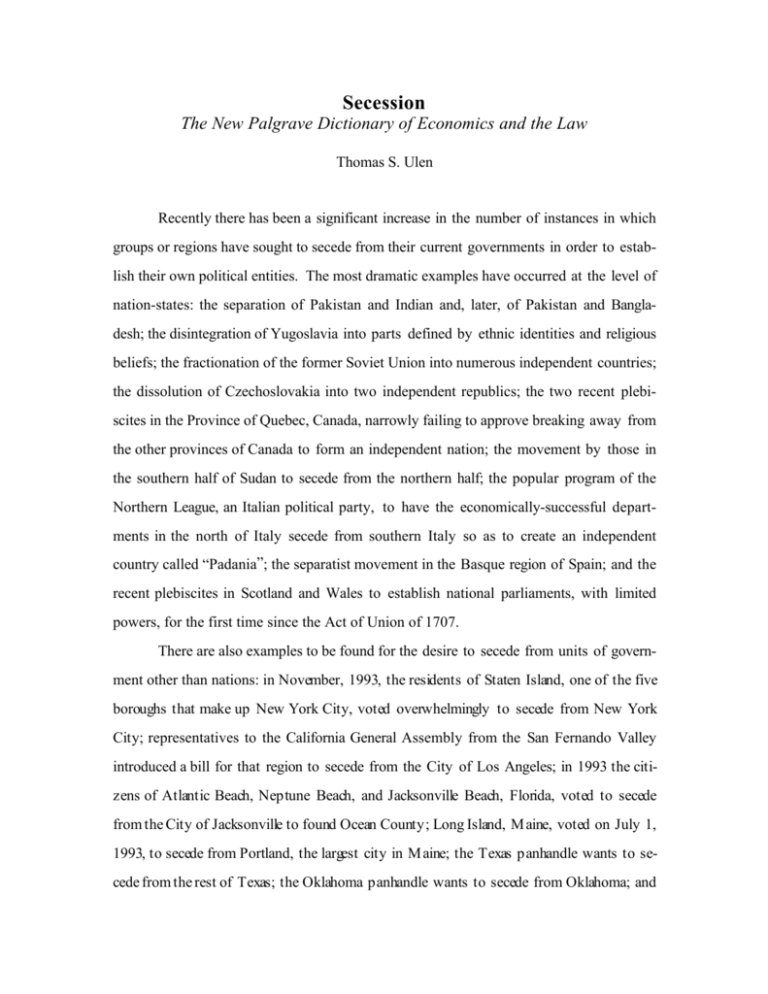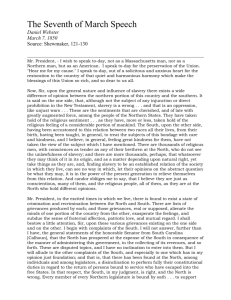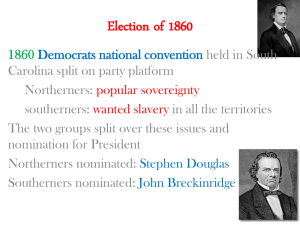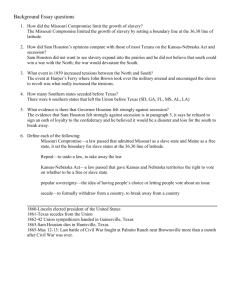Secession - Institute of Government & Public Affairs
advertisement

Secession The New Palgrave Dictionary of Economics and the Law Thomas S. Ulen Recently there has been a significant increase in the number of instances in which groups or regions have sought to secede from their current governments in order to establish their own political entities. The most dramatic examples have occurred at the level of nation-states: the separation of Pakistan and Indian and, later, of Pakistan and Bangladesh; the disintegration of Yugoslavia into parts defined by ethnic identities and religious beliefs; the fractionation of the former Soviet Union into numerous independent countries; the dissolution of Czechoslovakia into two independent republics; the two recent plebiscites in the Province of Quebec, Canada, narrowly failing to approve breaking away from the other provinces of Canada to form an independent nation; the movement by those in the southern half of Sudan to secede from the northern half; the popular program of the Northern League, an Italian political party, to have the economically-successful departments in the north of Italy secede from southern Italy so as to create an independent country called ÒPadaniaÓ; the separatist movement in the Basque region of Spain; and the recent plebiscites in Scotland and Wales to establish national parliaments, with limited powers, for the first time since the Act of Union of 1707. There are also examples to be found for the desire to secede from units of government other than nations: in November, 1993, the residents of Staten Island, one of the five boroughs that make up New York City, voted overwhelmingly to secede from New York City; representatives to the California General Assembly from the San Fernando Valley introduced a bill for that region to secede from the City of Los Angeles; in 1993 the citizens of Atlantic Beach, Neptune Beach, and Jacksonville Beach, Florida, voted to secede from the City of Jacksonville to found Ocean County; Long Island, M aine, voted on July 1, 1993, to secede from Portland, the largest city in M aine; the Texas panhandle wants to secede from the rest of Texas; the Oklahoma panhandle wants to secede from Oklahoma; and Secession New Palgrave Dictionary of Economics and the Law nine counties in Kansas have used the phrase, ÒWeÕre not in Kansas anymore, TotoÓ from The Wizard of Oz to dramatize their desire to secede from that state. The issue of secession has arisen not only when political units wish to split apart bit also when they wish to come together, as in the creation of new nations in Eastern Europe, the former Soviet Union, and elsewhere. There the matter presents itself in the negotiations about the founding document of the new nation. Should the new nation allow for secession and, if so, under what terms and conditions? Should secession be as easy as it nominally was in the former Soviet Union (Art. 72 of the Constitution (Fundamental Law) of the Union of Soviet Socialist Republics read, ÒEach Union Republic shall retain the right freely to secede from the USSR.Ó)? Or should secession be difficult, if not impossible? M ost of these negotiations are so highly contextualized that the parties are not able to step back from the immediate circumstances in order to consider the broader costs and benefits of secession. Instead, they deal with secession as one of many complicated issues that must be resolved, rather than as a salient issue in nation-formation. There is no settled learning on secession. As a result, none of the controversies mentioned above is easily resolvable by reference to well-known political theory. Commentators discuss secession either by analogyÑto breach of contract, the break-up of partnerships, or the dissolution of a marriageÑor on a case-by-case basis. Neither of these methods is entirely satisfactory. This essay seeks to use economic analysis to outline a comprehensive theory of secession. A. Theories of political obligation and their implications for a theory of secession Here I shall describe and evaluate two important theories, the first a theory of political obligation with strong implications about secession and the other an explicit moral theory of secession. 1. Consent theory 2 Secession New Palgrave Dictionary of Economics and the Law According to a widely-held theory, citizens incur political obligations only through their consent. (Beran 1987) If consent is a necessary condition for political obligation and may be freely given, then it may be freely withdrawn. Presumably, those unhappy with the government under which they live may withdraw their approval and found an alternative government to which they do consent. As a result, governmental units seem to be fluid and contingent, coming and going as the consent of the governed alters. The implications of this theory were profoundly debated in the 19th century United States with respect to the obligation of the constituent units of a federation to the continuation of the union, and the modern debates echo much that was said then. The issue of the legitimacy of secession centered on the theory to which the states had subscribed in forming the Union in 1787. One such theory, championed by the great Southern leader, John C. Calhoun, (but a theory originated by Pufendorf and M ontesquieu) held that the federal republic was the result of a compact among the states and that, as with all civil agreements, each member had the right to leave the compact. Calhoun gave no comprehensive account of the grounds that justified breaking the compact, but he clearly believed that bad faith by the government freed the constituents of their obligation to continue under the compact. (Calhoun, 1953; Beer, 1993) Thus, Calhoun asserted, the bad faith of England toward their American colonies justified their rebellion against and secession from England, and the bad faith of the United States federal government toward the Southern states would justify their secession from the Union. In contrast, other writers of the period held that the formation of a government was more than a mere contract and was not subject to renegotiation and termination according to the vicissitudes of the parties. How much more than a mere contract was not clear, but these writers sensed that the analogy to private bargaining among contractual partners was inapt. For example, Edmund Burke wrote, ÒThe state ought not to be considered as nothing better than a partnership agreement in a trade of pepper and coffee, calico or tobacco, or some other such low concern, to be taken up for a little temporary interest, and to be dissolved at the fancy of the parties,Ó but rather as Òa partnership in all science: a partnership 3 Secession New Palgrave Dictionary of Economics and the Law in all art; a partnership in every virtue and in all perfection.Ó (Burke, 1793: 147) The Articles of Confederation, which preceded the 1787 United States Constitution, captured this view in its mention of a Òperpetual union,Ó with its suggestion that exit was not to be contemplated under any circumstances. (One of the motivations for that Constitution was to Òform a more perfect union.Ó) Delegates to the New York State ratification convention for the new United States Constitution raised the possibility of Òconditional ratification,Ó with one of the conditions being the right to secede. One of the foremost defenders of the Constitution, James M adison, responded in Federalist 39 that the constitutional compact could be broken only by unanimous consent of all the states. (M adison, Hamilton, and Jay, 1788). This was certainly the view that motivated Abraham Lincoln and the Congress to fight the U.S. Civil WarÑnamely, that the Union could not legitimately be broken by unilateral action but only by unanimous consent of the constituent states. (Lincoln, however, fostered the secession of the mountainous western part of Virginia into the new state of West Virginia.) 2. Evaluation of the consent theory of secession There are clear benefits and hidden costs to the ease of secession implied in the consent (or compact) theory of political obligation. One benefit is that if a government must command consent in order to be legitimate, then governmental officials will channel their efforts into those actions most likely to induce citizensÕ consent. A government premised on consent must be responsive to citizensÕ desires, and this clearly resonates with the widelyshared presumption in favor of democracy. Another benefit of relatively easy secession follows from the Tiebout model of local expenditures on public goods and other government-provided goods: increased competition among governing units (as would occur, for example, when local governments proliferate) leads to greater citizen well-being. (Tiebout, 1956) However, the costs imposed on society by the ease of secession implied in the consent theory may be considerable. There are two particular concerns. First, because citizens 4 Secession New Palgrave Dictionary of Economics and the Law may withdraw their consent and, therefore, their tax revenues, government may not be comfortable in making long-term commitments and investments. This may be the case even though the vast majority of the governed might be willing to give their consent to longer-term governmental commitments and investments. Second, the ease of secession and the resulting contingency of governmental action may induce undesirable strategic behavior by some groups of citizens. The threat to withdraw consent in order to stop the implementation of some governmental actions or to compel the government to adopt a groupÕs favored policies may complicate governance considerably. The costs of allowing easy secession may be so substantial as to exceed their benefits. To insure that the benefits exceed the costs, the consent theory must elaborate a more nuanced version of what it means to consent to be governed and must propose constraints on the right to withdraw consent or to secede. Some consent theorists have recognized this problem and have proposed limitations on the ability to withdraw from a consent-based government. For instance, Beran says that a group may legitimately secede if (1) it is a substantial fraction in its portion of the state, and (2) it has the resources to be a viable independent state. (Beran, 1987) But these limitations do not seem adequately to address the concerns above about long-term commitments and investments and strategic behavior. 3. A moral theory of secession In a series of recent works, Buchanan has argued against the general recognition of a right of secession in international law. (Buchanan, 1991; 1995; 1997) His argument is that the principal moral duty of the state is to secure distributive justice. This involves, inter alia, redistribution of resources from rich to poor. Buchanan believes that if secession were too easy, then the moral duty of the redistributive state would be easily and immorally circumvented by the rich regions of nations seceding so as to preserve their wealth. The ÒhavesÓ would form their own association or exclude the Òhave nots.Ó ÒDemands for secession and for devolution from the centralized state to a federal system can 5 Secession New Palgrave Dictionary of Economics and the Law signal a rejection of the idea of the redistributive state in favor of the idea of the state as nothing more than an association for maximizing self-interest.Ó (Buchanan, 1991: 124) Buchanan does not reject the notion of secession entirely, only as what he calls a Òprimary right.Ó He believes that secession should be recognized in only two circumstances, both characterizable as circumstances in which secession remedies a past wrong. The first instance in which he would allow secession is to correct an immoral merger that occurred in the past, as in the Baltic States of the former Soviet Union, which had been forcefully annexed in the late 1930s. (Wellman, 1995) The second is to recognize seceding states Òif and only if [the group] has suffered certain injustices, for which secession is the appropriate remedy of last resort.Ó (Buchanan, 1997: 34-35) Even in these instances, Buchanan believes that there ought to be a significant hurdle for the secessionists to clear before their action becomes legitimate. 4. Evaluation of the moral theory of secession BuchananÕs moral theory of secession advances our understanding significantly, but it is still not completely satisfying. First, while the case for allowing secession of a group who have been unjustly conquered and absorbed by another country is compelling, the case for allowing other ÒpeoplesÓ who have not been conquered to secede is not at all straightforward. No doubt, case-by-case analysis can help to clarify when a group qualifies as a ÒpeopleÓ who deserve an independent nation. Still, defining a ÒpeopleÓ for the purpose of making a case for nationhood may be difficult, as we have seen in the former Yugoslavia. In addition, there are possible inducements to inefficient strategic behavior if it is known that international law supports a claim for secession on the ground of selfdetermination. Second, there are policies well short of secession that a just state can employ to accommodate a group to whom injustice has or might be done. Buchanan recognizes this but does not, I believe, give this matter sufficient weight. I elaborate below. Third, BuchananÕs theory may correctly conclude that secession ought to be diffi- 6 Secession New Palgrave Dictionary of Economics and the Law cult, but I am not convinced that he has correctly identified the reasons that it ought to be difficult, and as a result, he may inappropriately define (both too broadly and too narrowly) the circumstances in which secession is desirable. B. An economic theory of secession To begin the development of an economic theory of secession, imagine the rational deliberations of those who wish to form a new nation. We shall focus on two issues: why the parties desire to unite, and what provision they might include in their founding document regarding secession? These ex ante considerations will be made behind the Rawlsian veil of ignorance. 1. The optimal size of a governmental unit An economic reason for forming a new government or adjusting the size of a government is to take advantage of economies of scale in the provision of governmental services. (Barro, 1996) For example, it may be collectively cheaper for independent nations to consolidate their tax collection agencies or their defense expenditures rather than to do them independently. This is precisely what happened in the late 19th century in the creation of New York City. Under prodding from New York State the many jurisdictions around New York Harbor consolidated into a new metropolitan government, New York City, so as to realize economies of scale. (Briffault, 1992) Notice that for this economic reason to justify formation of a new nation or other governmental unit by consolidation, the economies of scale must be realizable across a very wide spectrum of governmental services. If the economies are available in only a limited number of those services, a limited agreementÑe.g., the creation of a unified tax-collection agency or of a mutual defense pactÑmay be superior to consolidation. Just as economies of scale may give rise to a move to increase the size of a nation, so, too, can they give rise to a desire to reduce the size of government: technological change may reduce the optimal scale for the provision of government services. The 7 Secession New Palgrave Dictionary of Economics and the Law spread of secession movements noted earlier may be nothing more than a readjustment of the optimal size of government in light of modern technology. Presumably, rational deliberators in forming a new government will recognize the fact that the optimal size of their government may change over time and will make provision for the orderly adjustment. Specifically, they might want to allow for secession in response to changes in the optimal size of government and to structure the terms and conditions under which that secession may occur so as to minimize the inefficiencies of strategic threats to secede noted above, while also minimizing the transition costs from a larger to a smaller government. As an example of the fact that these things can happen by agreement, consider the peaceful separation of Norway from Sweden in 1905. Indeed, fully rational deliberators behind the veil of ignorance may also recognize that there are other reasons that may give rise to a desire to secede besides the adjustment to changing optimal size of government due to technological changeÑe.g., the appearance of a new religious group within the society that desires to be independent. And they may wish to make accommodation for these additional reasons for secession. 2. The terms and conditions for optimal secession How, if at all, should the foundational agreement provide for the possibility of secession by a part of the new government? One possible course of action for the deliberators is not to worry about the terms and conditions of secession. A justification for this attitude might be a belief that a situation to secede from the government, if it arises, will take care of itself by means of a Coasean bargain. If there is a cooperative surplus that might be split between the parent government and the seceding unit (i.e., if it is worth more to the secessionists to secede than it is to the parent government to retain the prospective secessionists within the government) and if the transaction costs between them are low, then the parties will reach a mutually-beneficial agreement, regardless of the foundational agreementÕs position on the ease or legality of secession. But are the transaction costs between a seceding group and a parent government 8 Secession New Palgrave Dictionary of Economics and the Law likely to high or low? OneÕs instinct is to believe them to be high. There may be many parties involved; the issues may be unclear or complex; and emotions and high principles of equity are frequently involved. If so, then, even when there is a cooperative surplus, the secession may not happen by means of negotiation. A policy of doing nothing about secession may not, therefore, be a wise one. As a result, rational deliberators contemplating the creation of a new government will want to make some explicit provision for secession. But precisely what terms and conditions for secession would be wise? We can deal with the extremes quickly. A policy of making secession extremely easy is ill-advised. As we have seen, easy secession will make the government and private parties reluctant to make long-term commitments and investments in a potentiallyseceding region. Consider a situation in which valuable underground resources reside in a distant portion of the country, the majority of whose population is an ethnic group who constitute a small minority of the population of the larger country. To develop the valuable resources, private individuals and the national government must invest in roads or other transportation into the region, capital equipment with which to extract the resources, processing facilities, training, and so on. Not much of this is likely to occur if the distant region is likely to secede. Moreover, imagine the complex negotiations that would have to take place between the national government, private investors, and the ethnic minority about the appropriate compensation for the transportation and other capital facilities that would be lost if the investments had been made and region desired to secede. A second reason for not making secession easy, also noted above, is that if secession is too easy, then there is a risk of strategic behavior. ÒA right to secede will encourage strategic behavior, that is, efforts to seek benefits or diminish burdens by making threats that are strategically useful and based on power over matters technically unrelated to the particular question at issue.Ó (Sunstein, 1991: 649-50) A third consideration is that id secession is very difficult, the behavior of the constituent groups in the nation will be channeled into the usual political devices of the state. ÒIn a marriage, the understanding that the unit is not divisible because of current dissatisfac- 9 Secession New Palgrave Dictionary of Economics and the Law tion, but only in extraordinary circumstances, can serve to promote compromise, to encourage people to live together, to lower the stakes during disagreements, and to prevent any particular person from achieving an excessively strong bargaining position.Ó (Sunstein, 1991: 650) By contrast, if nation-ending (or divorce) were too easy, then there would be too many nations (marriages) and too little effort put in to getting beyond temporary disagreements. At the other extreme, a policy of forbidding secession is also ill-advised. If secession is impossible and, as we have seen, impracticable because of high transaction costs, then a group unhappy with the current configuration may believe that the only realistic course by which to achieve their aims is armed rebellion. That is clearly not desirable. Elimination of the extremes of too-easy and impossible secession argues for a policy of making secession difficult but not impossible. What terms and conditions for a legitimate secession ought one to contemplate imposing in the foundational agreement? Generally speaking, secession ought to be considered much like the power to amend the foundational document: it should not be impossible to do, but it should be so difficult to do that it is not done casually but only in circumstances commanding wide assent. For example, to amend the United States Constitution requires approval of two-thirds of each house of Congress and three-quarters of the states. In keeping with this general point, Sunstein (1991) suggests that if the right to secede is constitutionalized, it should be hedged around with qualifications and limitations. Four possibilities present themselves. First, secession should be allowed only if a supermajority of the subunit wants it. Second, secession should be allowed only under certain enumerated circumstancesÑe.g., when there is economic exploitation or injustice of a specified kind. Third, there should be prolonged deliberation before secession can take placeÑe.g., there might have to be more than one plebiscite, separated by a stated term of months or years. Fourth, the right to secede should be non-justiciableÑi.e., a right that courts will not recognize or enforce. Secession is essentially a political question should be resolved by political means. 10 Secession New Palgrave Dictionary of Economics and the Law On reflection, Sunstein believes that even these qualified conditions are dangerous and that there should be no constitutional right to secede. Each of the conditions can be abused, and, importantly, there are less drastic means of resolving the problems that give rise to the call for secession. I, however, find his conditions attractive and practicable methods of achieving the end of making secession difficult but not impossible in a nationÕs founding agreement. The founding agreement can also relieve secessionist pressures by including other provisions. For example, the United States ConstitutionÕs First Amendment, by guaranteeing freedoms of religion and of speech and of association, allows groups who might otherwise agitate for separation to feel relatively comfortable remaining within the nation. The structure of the governmentÑnot just the explicit terms of the foundational agreementÑmay be a device by which to deal, prospectively, with secessionist pressures. For example, a federal structure, rather than a unitary state, might reduce pressure for secession because the constituent units of a federation retain some sovereignty, which allows them to protect regional differences that, if not otherwise accommodated, could induce a desire for secession. A second structural adjustment is to recognize special rights for identifiable ascriptive groups in the foundational agreement. By making this initial accommodation, the larger society may spare itself later pressures for secession from these groups. The United States has, to a degree, adopted this structural solution to secession pressure for Native Americans and the Amish. Canada, in an effort to ameliorate separatist pressure in Quebec, has made special provisions for accommodating the Quebecois within the national federation. Finally, we might consider whether a particular nationÕs decision about allowing secession could be construed to impose external costs or to confer external benefits on other nations. The proliferation of nation-states may impose costs on other nations directly, through requiring them to establish new diplomatic arrangements or providing aid to the new nation. But it seems unlikely that these costs are so great as to warrant, on 11 Secession New Palgrave Dictionary of Economics and the Law economic grounds, international lawÕs being concerned about secessionÕs being too easy. As to external benefits, one could make the case that, following the Tiebout model noted earlier, a proliferation of new governments makes people in other nations generally better off by offering them more competitive economies and governments. 3. Ex post instances of secession We have been considering the advisability of secession in the imagined deliberations for a new government as a method of deriving some general principles about secession. In practice, secessionÕs advisability almost invariably arises in highly-particularized and emotionally-charged circumstances in which the foundational agreement or other controlling law is silent on the legality of secession. Most of the examples given at the beginning of this essay fit this description. While the general principles developed above may be helpful in beginning the consideration of whether or not secession in any particular circumstance is advisable, ultimately in these ex post instances the particular facts of the situation and the judgment of those familiar with those facts will be controlling. Cases Texas v. White, 74 U.S. 700 (1869). Bibliography Amar, Akhil Reed. 1987. Of Sovereignty and Federalism. Yale Law Journal, 96: 1425 Ð 1520. Barro, Robert J. 1996. Getting it right: Markets and choices in a free society. Cambridge: M IT Press. Beer, Samuel. 1993. To make a nation: The rediscovery of American federalism. Cambridge, M A: The Belknap Press of Harvard University Press. Beran, Harry. 1987. The consent theory of political obligation. London: Croom Helm. 12 Secession Briffault, Richard. New Palgrave Dictionary of Economics and the Law 1992. Voting rights, home rule, and metropolitan governance: The secession of Staten Island as a case study in the dilemmas of local self-determination. Columbia Law Review, 92: 775 - 850. Buchanan, Allen. 1991. Secession: The morality of political divorce from Fort Sumter to Lithuania and Quebec. Boulder, CO: Westview Press. Buchanan, Allen. 1995. Federalism, secession, and the morality of inclusion. Arizona Law Review, 37: 53 - 63. Buchanan, Allen. 1997. Theories of secession. Philosophy & Public Affairs, 26: 31 - 61. Burke, Edmund. 1993, orig. 1793. Reflections on the revolution in France. New York: Oxford University Press. Calhoun, John C. 1953. A disquisition on government. New York: The Liberal Arts Press. M adison, James, Alexander Hamilton, and John Jay. 1987, orig. 1788. The federalist papers. New York: Penguin Press. Sunstein, Cass R. 1991. Constitutionalism and secession. University of Chicago Law Review, 58: 633 - 70. Tiebout, Harry. 1956. A pure theory of local expenditures. Journal of Political Economy, 64: 416 - 32. Wellman, Christopher. 1995. A defense of secession and political self-determination. Philosophy & Public Affairs, 24: 357 - 72. 13





